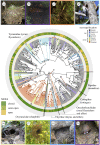Evolution of nest architecture in tyrant flycatchers and allies
- PMID: 37427478
- PMCID: PMC10331913
- DOI: 10.1098/rstb.2022.0148
Evolution of nest architecture in tyrant flycatchers and allies
Abstract
Innovations in nest design are thought to be one potential factor in the evolutionary success of passerine birds (order: Passeriformes), which colonized new ecological niches as they diversified in the Oligocene and Miocene. In particular, tyrant flycatchers and their allies (parvorder: Tyrannida) are an extremely diverse group of New World suboscine passerines occupying a wide range of habitats and exhibiting substantial extant variation in nest design. To explore the evolution of nest architecture in this clade, we first described nest traits across the Tyrannida phylogeny and estimated ancestral nest conditions. We then quantified macroevolutionary transition rates between nest types, examined a potential coevolutionary relationship between nest type and habitat, and used phylogenetic mixed models to determine possible ecological and environmental correlates of nest design. The Tyrannida ancestor probably built a cup nest in a closed habitat, and dome nests independently evolved at least 15 times within this group. Both cup- and dome-nesting species diversified into semi-open and open habitats, and we did not detect a coevolutionary relationship between nest type and habitat. Furthermore, nest type was not significantly correlated with several key ecological, life-history and environmental traits, suggesting that broad variation in Tyrannida nest architecture may not easily be explained by a single factor. This article is part of the theme issue 'The evolutionary ecology of nests: a cross-taxon approach'.
Keywords: Tyrannida; cup; dome; flycatcher; nest architecture; nest type.
Conflict of interest statement
We declare we have no competing interests.
Figures




Similar articles
-
Nest site correlates with nest type and body size in Troglodytidae passerines.Biol Lett. 2024 Aug;20(8):20240053. doi: 10.1098/rsbl.2024.0053. Epub 2024 Aug 28. Biol Lett. 2024. PMID: 39191286 Free PMC article.
-
Global drivers of variation in cup nest size in passerine birds.J Anim Ecol. 2023 Feb;92(2):338-351. doi: 10.1111/1365-2656.13815. Epub 2022 Oct 2. J Anim Ecol. 2023. PMID: 36134498 Free PMC article.
-
Open cup nests evolved from roofed nests in the early passerines.Proc Biol Sci. 2017 Feb 8;284(1848):20162708. doi: 10.1098/rspb.2016.2708. Proc Biol Sci. 2017. PMID: 28148749 Free PMC article.
-
The evolution of nest site use and nest architecture in modern birds and their ancestors.Philos Trans R Soc Lond B Biol Sci. 2023 Aug 28;378(1884):20220143. doi: 10.1098/rstb.2022.0143. Epub 2023 Jul 10. Philos Trans R Soc Lond B Biol Sci. 2023. PMID: 37427466 Free PMC article. Review.
-
The Evolution of Using Shed Snake Skin in Bird Nests.Am Nat. 2025 Feb;205(2):170-183. doi: 10.1086/733208. Epub 2024 Dec 18. Am Nat. 2025. PMID: 39913940 Review.
Cited by
-
Nest site correlates with nest type and body size in Troglodytidae passerines.Biol Lett. 2024 Aug;20(8):20240053. doi: 10.1098/rsbl.2024.0053. Epub 2024 Aug 28. Biol Lett. 2024. PMID: 39191286 Free PMC article.
-
The evolutionary ecology of nests: a cross-taxon approach.Philos Trans R Soc Lond B Biol Sci. 2023 Aug 28;378(1884):20220136. doi: 10.1098/rstb.2022.0136. Epub 2023 Jul 10. Philos Trans R Soc Lond B Biol Sci. 2023. PMID: 37427472 Free PMC article.
-
Bird nest building: visions for the future.Philos Trans R Soc Lond B Biol Sci. 2023 Aug 28;378(1884):20220157. doi: 10.1098/rstb.2022.0157. Epub 2023 Jul 10. Philos Trans R Soc Lond B Biol Sci. 2023. PMID: 37427469 Free PMC article. Review.
-
Nest location and architecture as primary drivers of variation in UV reflectance in avian eggs.Proc Biol Sci. 2025 May;292(2047):20250180. doi: 10.1098/rspb.2025.0180. Epub 2025 May 21. Proc Biol Sci. 2025. PMID: 40393482 Free PMC article.
References
-
- Baptista LF, Trail PW. 1992. The role of song in the evolution of passerine diversity. Syst. Biol. 41, 242-247. (10.2307/2992524) - DOI
-
- Gill FB, Prum RO, Robinson SK. 2019. Ornithology, 4th edn. New York, NY: W. H. Freeman.
-
- Raikow RJ. 1986. Why are there so many kinds of passerine birds? Syst. Zool. 35, 255-259. (10.1093/sysbio/35.2.255) - DOI
-
- Collias NE. 1997. On the origin and evolution of nest building by passerine birds. Condor 99, 253-270.
-
- Irestedt M, Fjeldså J, Ericson PGP. 2006. Evolution of the ovenbird-woodcreeper assemblage (Aves: Furnariidae) - major shifts in nest architecture and adaptive radiation. J. Avian Biol. 37, 260-272. (10.1111/j.2006.0908-8857.03612.x) - DOI
Publication types
MeSH terms
LinkOut - more resources
Full Text Sources

